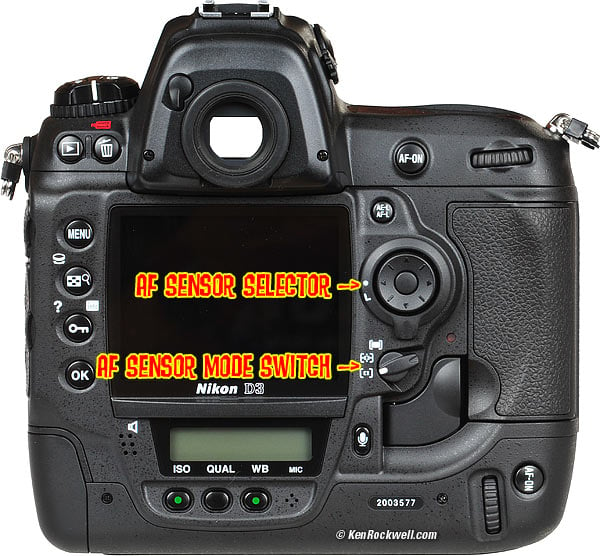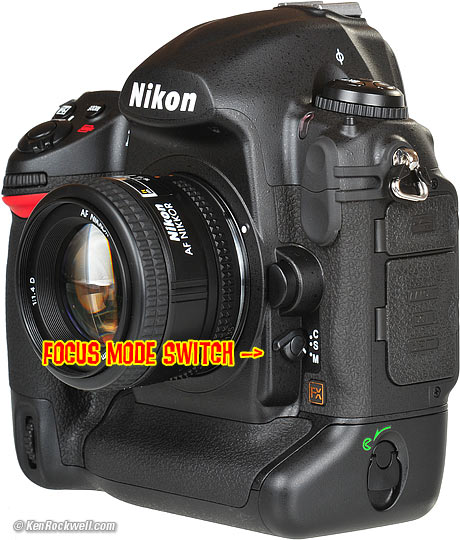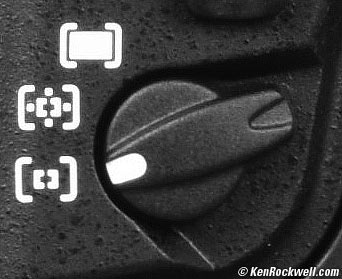Home Search Gallery How-To Books Links Workshops About Contact
Nikon D3, D3S and D3X AF Settings Nikon D3 Rear AF Controls. I get my goodies at Ritz, Amazon and Adorama. It helps me keep adding to this site when you get yours from those links, too. June 2008 Nikon D3 Review More Nikon Reviews
This is specific to the Nikon D3. See also my Guide to Nikon AF Settings for other cameras. Nikon D3 Focus Mode Switch. External Controls There are three controls, one on front and two on the back. Focus Mode Switch (front) The front Focus Mode Switch selects manual, or two kinds of autofocus. M is manual focus, like the 1950s. S is "AF-Single," in which position the camera focuses and then locks. C is "AF-Continuous," meaning the camera constantly tracks focus as the subject moves in and out. AF Sensor Selector (top rear) On the back, the top AF Sensor Selector selects among the many AF sensors, if you want to. AF Sensor Mode Switch (bottom rear)
Nikon D3 rear AF Sensor Mode Switch. The lower rear switch is the AF Sensor Mode Switch. It sets how the D3 uses the many AF sensors. There are three positions. From top to bottom, I call them the Big White Rectangle, the Crosshair, and the Tit. The Big White Rectangle mode lets the camera chose the AF points itself. It works great! The icon means that the D3 may use any of the sensors anywhere in the frame. The middle Crosshair position lets you choose the sensor, and then the camera moves it around to track action as selected by you in CSM a3 (MENU > CUSTOM SETTING MENU > a Autofocus > a3). The icon means that the D3 may move the sensor in any direction after you choose it. The D3 will move its choice in any direction, even though the simplified icon only shows four directions. The bottom Tit position selects only one fixed sensor at a time. The icon shows one fixed sensor.
Nikon's Default As shipped, move the front Focus Mode Selector to S, for AF-Single, point the camera at the subject, hold the shutter halfway, recompose, and shoot. This is exactly the same way Nikon's N2020 worked — back in 1985. The N2020 was marketed as "Dual Autofocus." That means it also had a continuous motion tracking mode. That's the C, as is Continuous, position of all Nikons today. Move the switch to "C" to track moving subjects, however you're still stuck with the center sensor. To get 23 years of improvements, you have to change the other settings. AF-S always focuses and locks, and AF-C always keeps tracking the subject. The AF Sensor Selector on the back has been the same since the F5 of 1996. Nikon calls this the "Multi Selector." Tapping the center gets you back to the center sensor. If you knock the "L - •" lever to "L," you'll lock yourself out of selecting the AF points, even though you can still navigate the menus.
I set the front switch to AF-C and the back switch to the Big White Rectangle. Then I just shoot. The D3 has so many AF sensors and have such intelligent logic that the "dummy" Big White Rectangle mode figures it out faster than I can. In this mode, the D3 magically and automatically identifies the correct AF sensor (or sensors) and uses them. I no longer have to pretend it's the 1990s and choose sensors manually, or pretend that it's the 1980s (or 1950s) and re-compose after focusing. The D3 does this with instantaneous speed and grace. Set this way, the D3 just focuses without me needing to do anything, and never clutters my finder with lit-up AF sensors. This is what sets the D3 apart from anything Nikon has ever made! Here are the details. If I don't mention a setting, I leave it at default or it's not related to focus. Front Focus Mode Switch: C, for AF-C, continuous tracking AF. Custom Setting Menu a1 (AF-C Priority selection): I set "Release + Focus." Once set, I've never changed this again. In the default of "Release priority," the camera just shoots, whether of not you're in focus. I never get any other than the first shot or two of a series in focus at this setting. It's a silly setting which makes the camera work fast in the store, but suck for moving subjects. In "Focus priority," the camera waits until each and every shot is in perfect focus. This slows it down — a lot. This is the default for the AF-Single setting for still subjects, but a bad idea for moving subjects. "Release + Focus" is an in-between setting, and it's perfect. I don't notice any slowing, but I do notice that almost all my shots are in focus, even in long sequences, and there is never any delay. I hit the shutter, and my D3 just shoots regardless of what's happening, like a missile's fire control system in battle short mode. Set this way, the D3 just shoots. If you're way out-of-focus you'll get a fuzzy first shot, but you won't miss it and the D3 will be in focus for the next shot as fast as it can. You'll never have to wait for the camera, and you'll get almost every shot sharp. Rear AF Sensor Mode Switch: I set it to the top setting, the Big White Rectangle mode. This means the D3 magically, and I mean magically, picks the right sensor or sensors. It's set to the Tit in the illustration at the top, and I call the middle setting the "Crosshair." In the Big White Rectangle mode, the D3 uncannily selects the nearest eyeball of a subject, even way off center. It's incredibly good, and that's why I let the camera do all the work. I can flick the AF Sensor Mode Switch without taking my eye from the finder, and I do whenever I need to. If the magic Big White Rectangle mode isn't choosing the AF points I want, or if I want to force them someplace, I choose another setting of the AF Sensor Mode Switch. The Tit mode at the bottom (as shown in the photo) forces the camera to just one sensor. The middle "Crosshair" position lets me choose the sensor, and then in AF-C mode, the camera moves the sensor around to track the subject. By setting the Custom Setting Menu a3 (Dynamic AF Area) to 51 Points (3D Tracking) in AF-C and the Crosshair mode, your manually-chosen AF point will magically move all around the frame tracking your subject! You'll see it move all around, and it really works. This only works in the Crosshair and AF-C mode; it doesn't move around in the Big White Rectangle, Tit or AF-S modes. This tracking mode gives us another way to shoot if you don't want to select a single AF sensor near your subject. If you prefer, you can autofocus with the center sensor, and in this 51-point 3D tracking mode, keep your finger on the shutter and the AF area will move all by itself, tracking the subject as you recompose!
More Settings The settings above let me just shoot. They work for sports and for still subjects. I just grab the camera and shoot. In AF-C and White Rectangle Modes, no AF sensors light up. You just shoot. Stills If I'm shooting still subjects, I might chose the AF-S (single focus and lock) mode on front. Now, in Big White Rectangle Mode, the selected sensors light up, and the focus locks as long as you hold the shutter halfway. If the camera's not magically selecting the sensors I want, I'll select them myself in the lowest "dot" (single-sensor) mode of the Rear AF Mode Selector. You're in luck if many sensors light in AF-S and Big White Rectangle modes. This means the camera knows all these areas are in perfect focus. Sports For sports with a lot of people running around, use AF-C, the 3D menu option (CSM a3), and the Crosshair mode on the AF Sensor Mode Switch. Now tell the camera which player is yours, and it will track them all over the frame.
Summary I set my D3 as described: AF-C (front switch) and Big White Rectangle (rear AF Sensor Mode Switch). Since the Big White Rectangle mode chooses the AF sensors for me, the AF Sensor Selector is ignored. If the D3 needs help finding the AF sensor I need, without moving my eye, I flick the AF Sensor Mode Switch to the middle Crosshair setting, which lets me choose the AF sensor to start and the D3 then tracks the subject. By tracking the subject, the D3 is so smart that it tracks the subject if the subject moves, or if I change my framing. Even with still subjects, I rarely need to set the D3 in AF-S (focus and lock) mode. This is another beauty of the D3: it's so smart that I don't need to twiddle with it as the subjects change from stills to sports, or even to hand it to a non-photographer. Set to my favorite settings, even my 17-month old kid makes great shots!
Acknowledgment: Many thanks to Lindsay Silverman of Nikon, who took my D3 aside and said "watch this" as he taught me how to use CSM a3, 3D tracking. Also after looking at my camera, I think it may have been Lindsay who set CSM a6, focus point illumination > brightness, to LOW to make them less obnoxious, but still quite visible. I doubt I ever would have found these on my own.
PLUG If you find this as helpful as a book you might have had to buy or a workshop you may have had to take, feel free to help me continue helping everyone. This page is free to read, but copyrighted. If you've gotten your D3 through one of my links or helped otherwise, you're family, so feel free to make a printout of this page for your camera bag. If you haven't helped and if you'd like permission to make a printed copy of this page, please help me with a gift of $5.00, half of what you'd pay for other camera-bag guides. I have to feed six mouths in addition to my own. Thanks for reading!
Ken |
Home Search Gallery How-To Books Links Workshops About Contact






